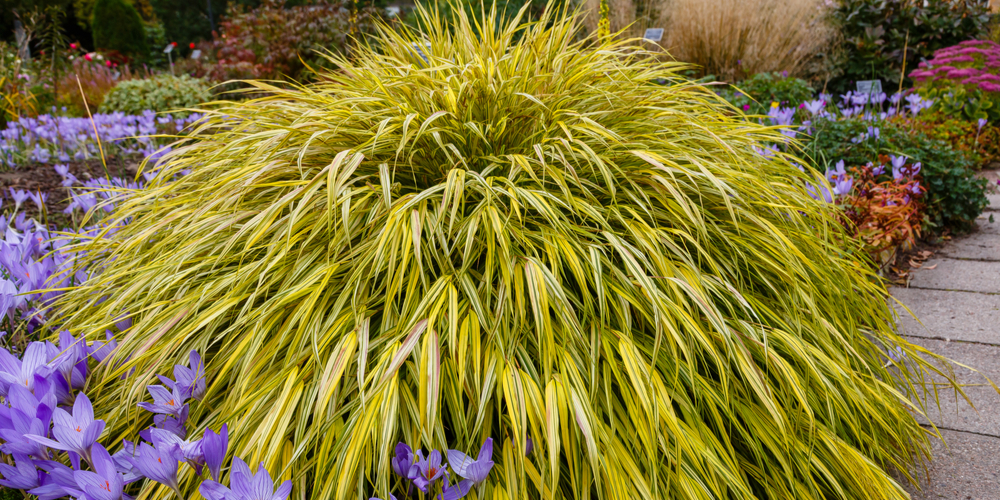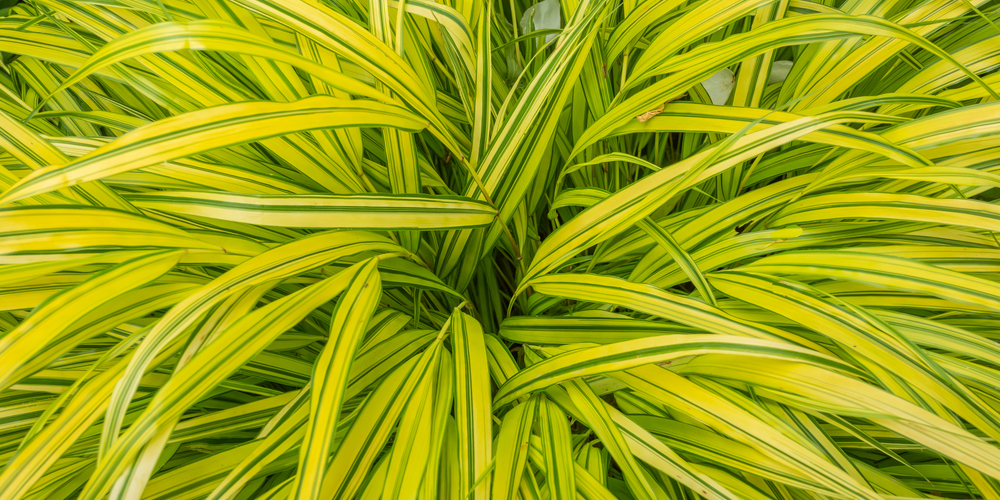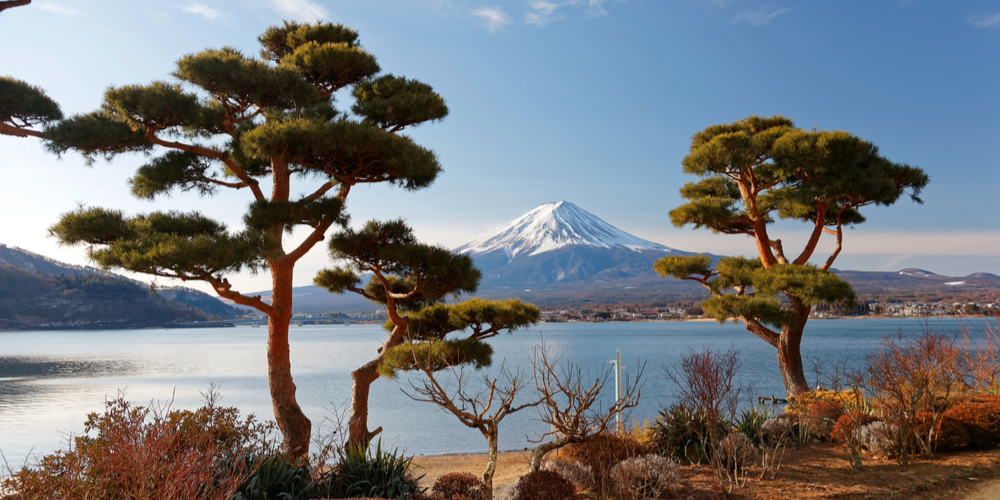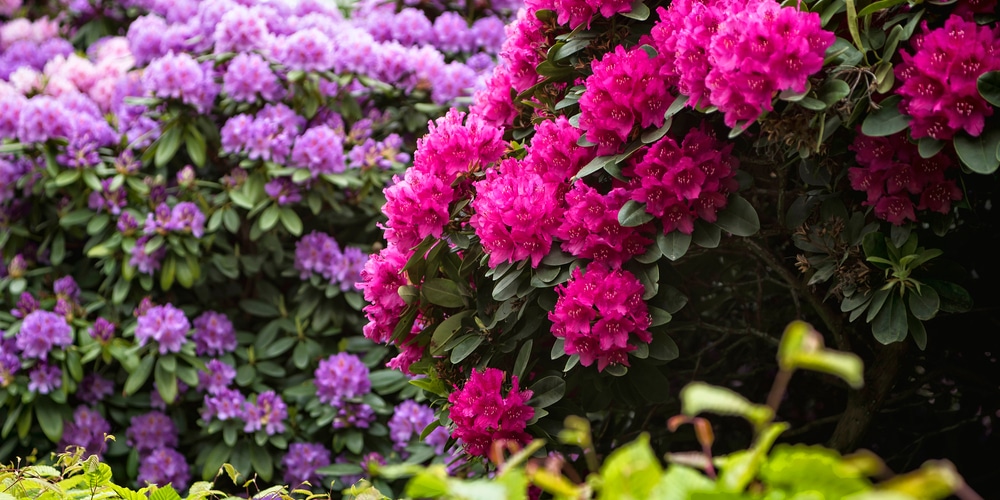Japanese Forest Grass is a lovely ornamental perennial that’s slow-growing. This variety of grass is relatively rare and thrives in shaded locations. It has long stems, about 10 inches in length, and produces a flower during the summer months. Japanese Forest Grass thrives in USDA zones 4 to 9.
Japanese Forest Grass does well in a rain garden. It also looks great in a Japanese garden with quince, maple, or black pine trees. As the grass likes shaded areas, it will grow well under trees. If you’re interested in adding Japanese Forest Grass to your landscape, read on. This article will discuss how to grow and care for Japanese Forest Grass, where to buy the plant, and which companion plants to choose.
What is Japanese Forest Grass?
Japanese Forest grass has long arching foliage that’s a beautiful, bright-green color. It has the Botanical name, Hakonechloa macra Aureola and is part of the Poaceae family. This variety of ornamental grass originates from Eastern Asia and is commonly found across Japan, especially in wooded areas. Japanese Forest Grass is often referred to as golden Hakone grass.
In the late summer, Japanese Forest Grass blooms with non-showy flower stalks, which will last throughout July, August, and September. The grass heads turn a rusty orange color during the fall and look stunning.
Japanese Forest grass can grow up to 18 inches in height. It grows in a mound of approximately 24 inches wide. Japanese Forest Grass provides an excellent ground cover, and as it likes shaded areas can be grown underneath larger shrubs and trees.
The grass looks great as part of a woodland garden and has green and golden foliage that will brighten up shaded areas. Alternatively, you can grow Japanese Forest grass in a container on a patio. When planted in a large pot, the foliage will grow over the edges and create a nice look. The grass is low maintenance when grown in a container, and as it’s relatively slow-growing, it won’t outgrow its pot for years.
Varieties of Japanese Forest Grass
There are a few different varieties of Japanese Forest Grass, each with slightly different foliage. The plants can also be grown in differing areas.
Hakonechloa macra Albostriata
The Hakonechloa macra Albostriata is also known as the Albostriata Japanese Forest Grass. This variety has beautiful green leaves with creamy stripes. These plants are more tolerant to heat and sun and can be grown in dabbled shade.
The Albostriata Japanese Forest Grass is a taller plant that can grow to a height of 36 inches. It’s also fast growing and cold tolerant, which makes it ideal for mild climates.
All Gold Hakonechloa macra
The all-gold hakonechloa macra is a relatively new variety of plant. It has bright leaves which stand upright and look spiky. These plants are smaller than other varieties of Japanese Forest Grass. They are also very slow-growing, so they can be planted in a pot on a patio.
Hakonechloa macra Benikaze
Benikaze roughly translates as ‘red wind.’ This plant is a lush green color throughout the spring and summer months. In the fall, it turns a beautiful red color when the weather starts to cool down.
How to Care for Japanese Forest Grass
Japanese Forest grass is easy to care for and will thrive in the correct climate. It’s low maintenance, pests, and disease resistant and is a shade-loving plant. It’s best to plant Japanese Forest grass in the early spring or the fall. Avoid planting grass seeds in the hot summer as the climate will be too hot and dry for the grass to thrive. Here are some tips to help you grow Japanese Forest grass in your yard or in a container on the patio.
Sunlight needs
Japanese forest grass grows best in partial shade or areas of dabbled light. These plants originate from woodland areas; they grow best if they are overshadowed by taller shrubs and trees.
If you live in a cooler climate, you may grow the grass in an area that gets sun for part of the day. Please don’t leave your plant in the full sun, or the tips of its leaves may become scorched.
The amount of sunlight this plant is exposed to will affect the color of its leaves. Partial shade will allow the plant to grow beautiful variegated leaves, while full shade will make the plant turn completely green.
Watering requirements
It’s best to frequently water your Japanese forest grass to keep the soil moist. Although this plant likes moist soils, it shouldn’t be planted in waterlogged ground, or it will suffer from root rot. Japanese Forest grass doesn’t like arid conditions, so it should be planted in the right climate and watered frequently if it’s to thrive.
You can also spread mulch around your Japanese Forest grass to help keep the soil moist and cool. Mulch is particularly beneficial during the summer as it will cool the earth and stop weeds from growing.
Pruning
During the late fall, you can remove any dead leaves. Alternatively, leave the dead foliage on the plant until the following spring. This will help to protect the plant. Trim the leaves with a sharp knife or gardening shears to improve the plant’s appearance.
Soil
As mentioned above, Japanese forest grass prefers soil that’s moist and able to retain moisture. It should also be well-draining as your plant’s roots shouldn’t be left sitting in water.
You can add organic matter such as compost or peat moss if your soil is too dense. This is best done before you plant your Japanese forest grass. If you decide to grow your Japanese forest grass in a container, choose one with drainage holes. This will help to reduce the chances of root rot as the soil will be less likely to become waterlogged. Ensure you place the pot in a shady spot that also receives some sunlight for part of the day.
Temperature
Japanese forest grass originates from cooler areas of Japan which get a lot of rain. They, therefore, like mild climates and should be kept moist. If you want to grow the plant in warmer weather, you’ll need to plant your Japanese forest grass in the shade and water it regularly.
This plant can do well in warmer areas with the correct care. Add a layer of mulch to the topsoil to keep the roots cool. Japanese forest grass isn’t resistant to frost or extreme heat. It’s a reasonably hardy plant that grows best in USDA zones 4 and 5.
Fertilizer
The best way to fertilize your Japanese forest grass is to use organic mulch to provide nutrients to the plant. If you plan to mulch your plant or use organic fertilizer, this job can be done in the early spring. You’ll only need to feed your plant once at the beginning of the growing season.
Japanese Forest Grass: Where to Buy
Japanese forest grass is a beautiful plant that is pretty rare. It can be easily grown via propagation. The grass does produce seeds, which form as a seed head after the flowers have bloomed. The seeds generally won’t grow, so it’s best to use propagation to create a new plant.
You can grow a new plant by division in the early spring. If you know someone that has Japanese forest grass, you can dig up a clump using a spade and then replant it in your own yard. If you decide to propagate, you should wait until the original plant has reached maturity. This will give you a greater chance of success. As this ornamental grass variety is slow-growing, you may have to wait years for it to form a large enough plant to divide.
If you don’t know anyone with a large clump of Japanese forest grass, you can buy the plant from a garden center or online store.
Where can I buy Japanese forest grass?
If you’re looking to buy Japanese forest grass, your local garden center or plant nursery is the best place to start. Even if the business doesn’t stock Japanese forest grass, they may advise you of where to buy the plant. Most garden centers sell small plants which can be easily transported and planted in your yard.
The plant can also be commonly found online in stores such as eBay, Etsy, and online garden centers. You can source this plant from all the major online retailers, and a small plant can be easily shipped to your home.
Japanese Forest Grass is relatively inexpensive, but it’s worth shopping around to get the best price. You should also remember that shipping costs will be added to the total price, making shopping online slightly more expensive, especially if you want to buy a larger plant.
Japanese Forest Grass Companion Plants
Japanese Forest Grass is commonly used as a groundcover. It can be grown in various different landscapes and works well with larger trees. Many people plant Japanese forest grass along the border of their paths, as the species isn’t invasive and looks excellent when fully grown. It can also be used to brighten up shaded areas and patios.
Which plant makes the best companion plant for Japanese forest grass
Japanese Forest Grass grows best when it has other plants growing alongside it. Your plant will thrive if it’s overshaded by a tree that provides partial shade beside it. If you’re looking to create a Japanese landscape, you may like to consider planting quince, cherry trees, or Japanese Maples.
Black Pines
Black pines, also known as Japanese pines, are native to Asia and commonly grow alongside Japanese Forest Grass. Pine trees look great in an Asian-style garden as they are evergreen and can be pruned to look like a cloud.
Japanese pines and Japanese forest grass not only look great together but also help to provide the correct type of soil. When the pine tree drops its needles, it will add nutrients to the earth. The needles will also make the soil more acidic and create the perfect growing conditions for smaller plants such as Japanese forest grass, azaleas, and rhododendrons.
Araiostegia parvipinnata
This beautiful fern is often referred to as the hare’s foot fern due to the shape of its leaves. The plants spread via rhizomes and make great grown cover for shaded areas. They can be planted alongside moss or Japanese Forest grass as these plants all thrive in moist soil and shady spots.
Rhododendrons
Rhododendrons also grow well alongside Japanese Forest Grass as they both like the same type of soil. These plants have beautiful pink flowers in the spring and, like Japanese Forest grass, need slightly acidic soil.
Styrax
Styrax japonicus is a small tree that’s also native to Japan. It has beautiful bell-shaped flowers throughout the summer months. These trees look lovely with Japanese forest grass planted underneath them; they also thrive in moist areas next to water or can grow along the edges of paths.
The Betula utilis is a great companion plant for Japanese Forest Grass, as is a Hydrangea macrophylla. As Japanese Forest Grass has yellow or cream foliage, it looks beautiful when planted near darker plants. Plants such as Coral Bells, Sweet potato vines, and celosia also make great companion plants.
Japanese forest grass companion plants: Conclusion
Japanese Forest Grass is a beautiful plant that grows quite tall and produces a mound. It likes to grow in a shaded area and needs to be watered regularly to keep the soil moist. These plants grow well in various landscapes. They can grow in multiple terrains, such as a wooden garden, flower border, or rain garden.
As the plants originate from cool, moist areas of Japan and Asia, it’s best to grow the grass in milder climates in a shaded area. These plants can also thrive in warmer places if they are grown in the shade and watered enough. It’s also beneficial to add a layer of mulch to the topsoil to keep your plant’s roots cool.



